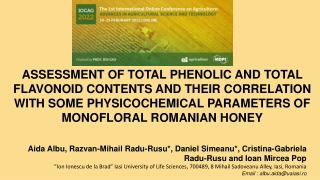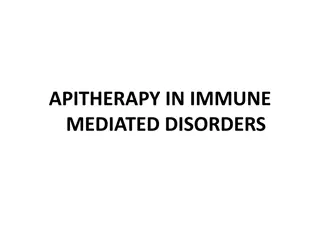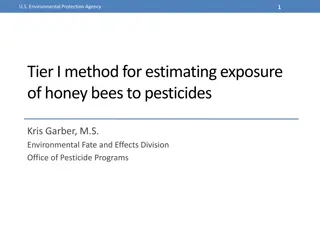Honey Bee Exposure to Pesticides: Routes and Impacts
Analysis by the U.S. Environmental Protection Agency outlines various exposure routes of honey bees to pesticides, including contact with contaminated sources like foliage and soil, ingestion of contaminated pollen and nectar, and inhalation of chemical droplets. Different application types and age groups of bees are considered, highlighting potential risks to adult worker bees and larvae. Understanding these exposure pathways is crucial for assessing the impact of pesticides on honey bee populations.
Download Presentation

Please find below an Image/Link to download the presentation.
The content on the website is provided AS IS for your information and personal use only. It may not be sold, licensed, or shared on other websites without obtaining consent from the author.If you encounter any issues during the download, it is possible that the publisher has removed the file from their server.
You are allowed to download the files provided on this website for personal or commercial use, subject to the condition that they are used lawfully. All files are the property of their respective owners.
The content on the website is provided AS IS for your information and personal use only. It may not be sold, licensed, or shared on other websites without obtaining consent from the author.
E N D
Presentation Transcript
U.S. Environmental Protection Agency 1 Exposure of Honey Bees to Pesticides and the Relative Importance of the Identified Exposure Routes Christina Wendel, M.S. Environmental Fate and Effects Division Office of Pesticide Programs
2 U.S. Environmental Protection Agency Outline Discussion of the potential exposure routes/pathways by application type and age of the bee (adult worker vs. larvae) Foliar Applications Soil Applications & Seed Treatments Exposure pathways considered and included in the Tier I exposure assessment Exposure pathways considered but not included in the Tier I exposure assessment
3 U.S. Environmental Protection Agency Potential Exposure Routes for Honey Bees Contact Direct spray, contaminated foliage and soil, dust, comb wax, propolis, and/or pollen Oral Dietary Pollen, nectar, honey, bee bread, royal jelly, and/or brood food Drinking water Ponds, puddles, dew, and/or guttation fluid Inhalation Spray droplets, and/or volatilized chemical
4 U.S. Environmental Protection Agency Foliar Spray Applications Exposure Routes Contact: Direct spray Adult Forager Bees Inhalation: Spray droplets or gaseous phase of chemical Oral: Collection and consumption of contaminated pollen, nectar, and/or drinking water Contact: With contaminated foliage, soil, comb wax, propolis and/or pollen
5 U.S. Environmental Protection Agency Foliar Spray Applications Exposure Routes Hive Bees (Adults and Larvae) Oral: Processing and consumption of contaminated pollen, nectar, and/or drinking water Inhalation: Gaseous phase of chemical Contact: With contaminated comb wax, propolis and/or pollen
6 U.S. Environmental Protection Agency Soil and Seed Treatment Applications Exposure Routes Forager bees and in hive bees (adults and larvae) Oral: Collecting, processing, and consumption of contaminated pollen, nectar, and/or drinking water Inhalation: Gaseous phase of chemical Contact: With contaminated dust, comb wax, propolis and/or pollen
7 U.S. Environmental Protection Agency Exposure Pathways in the Tier I Screen Contact with Direct spray, Contaminated foliage, soil, comb wax, propolis, and/or pollen Dust Oral Dietary Pollen, nectar Honey, bee bread, royal jelly, and/or brood food Drinking water Ponds, puddles, dew, and/or guttation fluid Inhalation Spray droplets, and/or gaseous phase of a volatilized chemical
8 U.S. Environmental Protection Agency Contact Exposure - Dust Potential major route of exposure for some pesticides and application scenarios Incidents of bee mortality related to dust exposure Rationale of not including this exposure route into Tier I screen for all pesticides Effective quantitative screening tool is not currently available Stewardship Programs Management of exposure through mitigation BMP s Seed coating technologies Alternative lubricating agents to talc and/or graphite
9 U.S. Environmental Protection Agency Oral Exposure Drinking Water Compared potential doses received through contact (direct spray) and oral (dietary) versus contaminated drinking water Ponds and Puddles Discountable relative to contact and dietary routes of exposure Dew and Guttation fluid Potentially significant based on conservative assumptions Investigated further
10 U.S. Environmental Protection Agency Dew and Guttation Fluid Exposures are not expected to be as significant when compared to diet because of two primary reasons 1. Time of day when available vs. foraging times for bees 2. Consumption rates from water vs. food
11 U.S. Environmental Protection Agency Estimated amounts of water consumed from food for adult bees Honey Nectar Worker Task Percent daily water flux consumed with food Percent daily water flux consumed with food Cell cleaning and capping 8% 84% Brood and queen tending (nurse bees) 22% 234% Comb building, cleaning and food handling 8% 84% Foraging (pollen) 7% 73% Foraging (nectar) 38% 409%
12 U.S. Environmental Protection Agency Inhalation Exposure Highly volatile pesticides i.e., fumigants Foliar and Soil applications Not relevant for seed treatment applications Hives in close proximity to treated site Currently evaluating the inhalation exposure pathway. Preliminary results suggest that exposure from inhalation is substantially lower than the dietary or contact exposure.
13 U.S. Environmental Protection Agency Summary of Pathways Considered Focused on routes that create the most substantial exposures Primary (major) routes of exposure: Contact - via direct spray, contact with contaminated dust on a case by case basis Oral - via Pollen and Nectar (assumed to be protective of honey, bee bread, royal jelly, brood food) Other routes of exposure: Contact via contact with contaminated foliage, soil, comb wax, propolis, and/or pollen Oral via consumption of contaminated drinking water Inhalation























